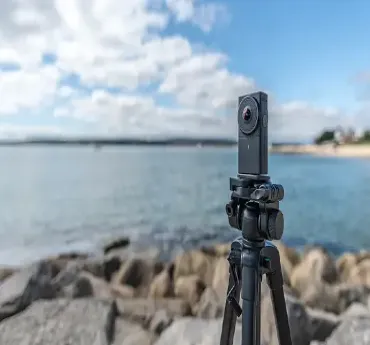In 2025, AI Video Enhancers Transform Video Production.
As the industry develops, video quality constantly evolves, and one’s tactic is to capture the audience and lure them. Nowadays, every creator and business desires some tools to transform their raw footage into cinematic masterpieces, since the age of 4K, 8K, and HDR videos are dominating. AI video enhancers are then the all-game revolutionizing technology of 2025; these tools are the multidimensional software that uses artificial intelligence to boost the video resolution, fine-tune quality, and take the pain out of tedious editing so that storytellers can focus more on story creation than technicalities.
In this post, we will cover the AI video enhancer, its key features, what one can expect from the trends in 2025, and its use to upscale your video production game.
What is an AI Video Enhancer?
An AI video enhancer is a software or device that performs its functions using artificial intelligence or machine learning techniques to enhance the visual and audio quality of video footage. AI video enhancers are used for upgrading your low-resolution, grainy, or obsolete footage. Using AI video enhancers, you can achieve sharper resolution, smooth imperfections, enhanced colors, and a very polished professional quality production.
For example:
- From 720P to 4K footage.
- Better on noise and artifacts from low-light videos.
- Automatically boost sharpness, contrast, and colors.
AI video enhancers in 2025 do much more than fix problems. They automatically convert ordinary footage into visually stunning, high-quality footage that meets today’s world-class standards.
How Important are AI Video Enhancers in 2025?
These days, people consume massive amounts of content, only to develop new expectations for immaculate visuals. Here is where AI video enhancers come into play:
Higher Video Quality Standards
Because there are now more 4K and 8K screens around the world, a low-quality video is not acceptable at all. These AI enhancers fill in the gap between a raw video and a professional-grade visual.
Domination of Social Media
Less than a few crisp, clean, and high-quality content uploads can merit a creator’s reward on platforms such as Instagram Reels, TikTok, and YouTube Shorts, and AI video enhancers help a creator to shine among the crowd in a feeder saturated with content.
Inclusiveness for All Creators
Further, gone are the days when only Hollywood can afford compelling post-, pre-, or during-production value. Today, even a hobbyist, marketer, or small business can avail of democratized video enhancement through the use of AI-powered tools.
Speed and Automation:
Traditional video editing consumes a lot of time. The processes are automated by AI video enhancers, thus results are obtained cheaply as per time and money but without affecting the quality
Key Features to Expect from AI Video Enhancers in 2025
AI video enhancers, from their inception, have developed cutting-edge features ranging from those that suit the neophyte to those that match professional creators. Here are some of the amazing features to expect in 2025:
Resolution Upscaling
- From SD or HD to 4K, 8K, or even more without a possible loss of quality, all that the AI is said to do is analyze frames with the missing detail and intelligently fill in the gap.
Noise Reduction
- Grainy, artifact, and noisy videos, recorded in low light or tough conditions, are possible to eliminate.
Color Grading and Enhancement
- Reversion of colors, brightness, and contrast, as well as adding cinematic tones to the footage, can also be done automatically.
Frame Rate Conversion
- Increase the frame rate at which you’ve been watching from 30fps to 60fps or even higher to view a smoother playback for slow motion or action shots.
Super-Slow Motion
- Machine learning intelligence or AI will give you the ability to predict and create some in-between shots for converting footage into very smooth slow motion.
Detection of Faces and Objects
- Sharpen specific areas such as faces or objects, ensuring the most important parts of the video are brought into focus.
Audio Refinement
- The latest innovations in advanced features and excellent tools come with audio enhancement, background noise reduction, and sound optimization.
Real-Time Processing
- Most advanced AI video enhancers of 2025 would boast of real-time processing, enabling their users to look at all enhancements in the process of doing so within task-run time.
Top AI Video Enhancers in 2025
Here are some of the ones who have gone with this AI video enhancer tool and have rocketed in the takeoff of the market:
Topaz Video AI
This one is more famous among filmmakers, making it a favorite for YouTuber users of this product. It’s in industry-leading resolution upscaling and noise reduction.
Runway ML
These kinds of tools combine multipurpose video enhancement benefits with other automated purposes such as AI-powered editing, from background removal to object tracking.
Pixop
The Pixop is a facilitated cloud portal to get your video automated enhancement within upscaling and color grading.
Adobe Sensei
Adobe Sensei is a part of the whole Adobe ecosystem; it uses AI to automatically edit videos in enhancement and correction.
Neural. love
Neural. love suits the best for creators wondering how upscaling an old footage can be possible. This resource is meant for restoring and enhancing obsolete videos.
All About Transforming Industries with AI Video Enhancer
AI video enhancers are for not only individual creators but also industries all over the world:
Entertainment
AI does not do the film restoration or the post-production. It brings filmmakers to make more beautiful things faster.
Marketing and Advertising
High-quality video content is crucial for keeping consumers’ attention. AI enhancers help brands produce much more polished ads and campaigns.
E-Learning
Using this technology, educational platforms can enrich their tutorial videos so that they will be more dynamic and professional.
Sport and Events
With the assistance of AI tools, the enhancement of footage recorded live generally smoothens action and adds detail as well, enhancing both viewer experience and video quality.
Social Media Influencers
Yet, this is not surprising: from TikTok to YouTube and Instagram, creators employ AI to make the content seem higher production value than what was possible with a simple phone camera.
Best Practices on Utilizing AI Video Enhancers Effectively
Here are the practices to follow to use the AI video enhancers effectively:
Capture High-Quality Footage
- Though AI could do a lot, good footage brings out the best in them.
Use LUTs and Presets
- Most of the AI tools offer preset-built or LUT support (Look-Up Tables), and this makes it a lot easier to maintain a good look.
Experiment with Settings
- Each tool is unique. Take the time to experiment with the settings until you settle on what works best for your footage.
Combining with Manual Editing
- AI is a powerful technology by itself, while when merged with manual adjustments, it can give birth to really professional-grade videos.
Get Updated
- In 2025, still, the new updates and features will roll out frequently. You need to keep your tools updated to access the latest advantages.
Future Trends of AI Video Enhancers
Integration with AR and VR
- As the content on AR and VR embarks, AI video enhancers are expected to step up the level of immersiveness to the next level.
Enhancements in Real-Time for Live Streaming
- Such facilities are going to be made available soon. With these real-time improvements, creators will be able to enhance their live videos for platforms such as Twitch and YouTube Live.
Eco-Friendly Technology
- Sustainability is now getting prioritized and would also reflect upon future tools being developed with modes of energy-efficient processing.
Personalized AI Models
- This is how AI tools will render learning-by-doing while getting adjusted to a creator’s individualistic style.
Conclusion
The demand for high-quality video content has risen to an all-time high as we approach 2025. These AI video enhancers come with the tools to help those in the film industry, marketing, and content creation to produce better visuals like professionals easily. These are all-in-one-combo tools that resolve everything from resolution upscaling through noise reduction to real-time processing, truly revolutionizing the face of video production.
So, what are you waiting for? Start using AI-powered video enhancers immediately and take your content to another higher level for tomorrow’s target. Whether you restore old footage or create brand-new masterpieces, AI helps create content quicker, easier, and more affordable.
Frequently Ask Questions
What is an AI video enhancer?
An AI video enhancer is a software or technology that uses artificial intelligence to improve video quality. It provides features like resolution enhancement, noise reduction, image sharpening, color correction, and the automation of tedious editing processes while giving professional results.
How does an AI video enhancer work?
AI video enhancers process video frames with machine learning algorithms, recognizing patterns and locating change areas, thereby upscaling them in terms of resolution, making color adjustments, and putting in extra detail to create sharper, cleaner images
Does an AI video enhancer enhance audio?
Most of the time, advanced features are captured by these AI video enhancers, which include audio enhancement, cleaner voice optimization, and background noise reduction
Do AI-based video enhancers support live streaming?
Yes; some AI video enhancers will be real-time, allowing the creators to stream live while improving the quality of their live streams in 2025
Are AI video enhancers pricey?
Depending on the features, AI video enhancer prices range from absolutely free through common premium tools for professionals, subscriptions, and pay-per-used models.


